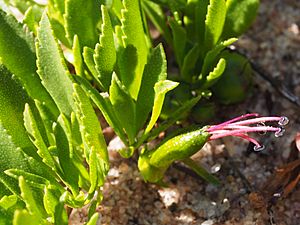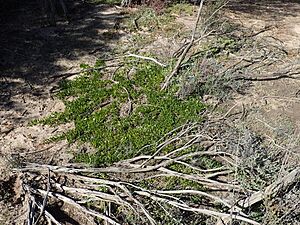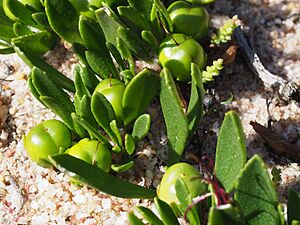Snake eremophila facts for kids
Quick facts for kids Snake eremophila |
|
|---|---|
 |
|
| Eremophila serpens growing near Lake King | |
| Conservation status | |
| Scientific classification | |
| Genus: |
Eremophila (plant)
|
| Species: |
serpens
|
The Eremophila serpens, also known as snake eremophila, is a cool flowering plant. It belongs to the figwort family, called Scrophulariaceae. This plant is special because it is endemic to Western Australia. This means it naturally grows only in that part of the world.
The snake eremophila is a low-growing, creeping plant. It has long branches that spread out along the ground. Its leaves often have bumpy edges. The flowers are yellowish-green with pretty red or brownish-purple marks.
Contents
What Does Snake Eremophila Look Like?
The snake eremophila is a shrub that grows close to the ground. It often has long, snake-like branches that spread out. These branches can form patches about 3 to 4 centimeters (1 to 2 inches) tall. They can spread up to 2.5 meters (8 feet) wide!
The branches are smooth and often touch the ground along their whole length. They can even grow roots where they touch the soil. The leaves grow one after another along the branches. They are shaped like a spear and often have small, uneven bumps along their edges. Most leaves are about 31 to 47 millimeters (1.2 to 1.9 inches) long and 8 to 12 millimeters (0.3 to 0.5 inches) wide.
Snake Eremophila Flowers and Fruits
The flowers of the snake eremophila grow alone or in pairs where the leaves meet the stem. They sit on short stalks, usually 4 to 7 millimeters (0.16 to 0.28 inches) long. The leaves often hide the flowers a little.
Each flower has 5 green, overlapping sepals. Sepals are like small leaves that protect the flower bud. These sepals are about 6 to 7 millimeters (0.24 to 0.28 inches) long. After the flower blooms, they grow bigger, up to 10 to 11 millimeters (0.39 to 0.43 inches) long.
The petals are 15 to 26 millimeters (0.59 to 1.02 inches) long. They join together at the bottom to form a tube shape. This tube is lime-green or yellowish-green. It has red or brownish-purple marks on its top part. The petals are smooth, except for some hairs on the lowest part and inside the tube.
The flower has 4 stamens, which are the parts that make pollen. These stamens stick out beyond the petal tube. They are the most noticeable part of the flowers. Snake eremophila usually flowers between March and December. After flowering, it produces dry, round fruits. These fruits are about 6.5 to 10 millimeters (0.26 to 0.39 inches) long and have a grey, papery covering.
How Was Snake Eremophila Named?
The snake eremophila was first officially described in 1979. A scientist named Robert Chinnock wrote about it in a science journal. The second part of its scientific name, serpens, is a Latin word. It means "snake." This name was chosen because of how the plant's long branches creep along the ground, like a snake.
Where Does Snake Eremophila Grow?
The snake eremophila grows in sandy soil. You can often find it near the edges of salt lakes. It grows in an area of Western Australia between the towns of Hyden and Salmon Gums. This area includes several different natural regions like the Avon Wheatbelt and Esperance Plains.
Is Snake Eremophila Protected?
Yes, the snake eremophila is a special plant. The Western Australian Government Department of Parks and Wildlife lists it as "Priority Four." This means it is rare or almost threatened. It needs to be looked after so it doesn't disappear.
Growing Snake Eremophila in Your Garden
The snake eremophila is a great plant to grow in a garden. It makes a nice groundcover, spreading out low to the ground. It also attracts birds that feed on nectar, like honeyeaters.
It's quite easy to grow new plants from cuttings. Cuttings are small pieces of the plant that can grow into a new plant. This plant can grow in many different types of soil. It doesn't need a lot of water, but it's good to water it sometimes if there's a long dry period. It can also handle frost, which means it can survive cold temperatures.




